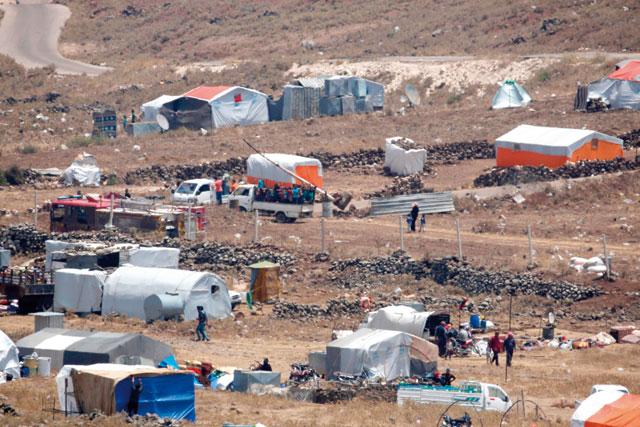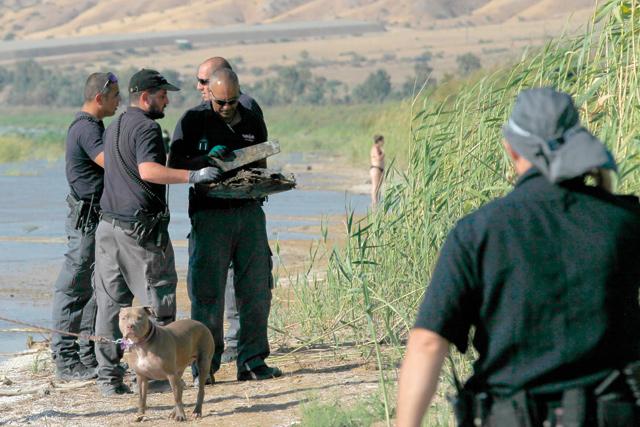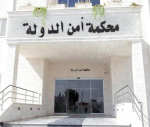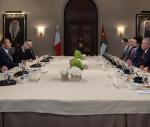You are here
Tel Aviv warns Syrians away from frontier as Assad closes in
By Reuters - Jul 18,2018 - Last updated at Jul 18,2018

A photo taken on Tuesday from the Israeli-annexed Syrian Golan Heights shows refugees coming to fence border between Syria and Israel by a camp for displaced Syrians near the Syrian village of Burayqah, in the southern province of Quneitra (AFP photo)
GOLAN HEIGHTS/BEIRUT — Dozens of Syrians approached the Israeli-occupied Golan Heights on Tuesday in an apparent attempt to seek help or sanctuary from a Russian-backed Syrian government offensive, before turning back after a warning from Israel's army.
Tens of thousands of Syrians have thronged to the Golan in the past month, fleeing a rapidly advancing offensive which has defeated rebels across a swathe of territory near Jordan and Israel and generated pressure on both neighbours to extend aid.
“Go back before something bad happens. If you want us to be able to help you, go back,” an army officer on the Israeli side of a frontier fence, which is partly lined with minefields, told the crowd in Arabic through a megaphone. “Get a move on”.
Explosions sent up smoke a few kilometres further within Syria, where President Bashar Assad’s offensive has triggered the single biggest displacement of the war — several hundred thousand people. Israel has refused to grant asylum to citizens of Syria, with which it is technically at war. But it has admitted thousands of them for medical treatment.
“I think that we have really done all that can be done,” Defence Minister Avigdor Lieberman told Tel Aviv radio station 103FM. “We are not prepared to accept even one refugee. That’s not our job. There are lots of Arab countries, rich countries.”
Israel captured much of the Golan in 1967 fighting with Syria and annexed the strategic plateau, a move not recognised abroad. Israeli aid, transferred by international humanitarian groups, flows across a 1974 armistice line to a UN-monitored buffer zone where many of the refugees are encamped, hoping Assad’s army will steer clear.
Too close for comfort
The Syrians who approached the fence stopped some 200 metres away. “You are on the border of the State of Israel. Go back, we don’t want to hurt you,” a soldier called out to them.
The crowd, which included women and children, then walked back slowly towards the refugee encampment. Some stopped mid-way and waved white cloths in the direction of the Israeli lines.
An Israeli officer, speaking to Reuters on condition of anonymity, said such processions towards the fence had happened before: “It’s their way of signalling they need new supplies.”
Assad has advanced swiftly, unopposed by his foreign adversaries. The United States, which once armed the southern rebels, told them not to expect it to intervene as the attack got under way last month. The United Nations said last week up to 160,000 Syrians had fled to Quneitra province, some close to the Golan.
Syrian state TV broadcast from Al Haara, a hill captured from rebels on Monday and overlooking the Golan. Government fighters waved rifles and held aloft pictures of Assad as they celebrated. “We will liberate all Syria,” said one of them. Israel has threatened a harsh response to any attempt by Syrian forces to deploy in the disengagement zone, complicating the offensive as it draws closer. Israel does not want its foes Iran and Hizbollah, both allies of Assad, to form their own Syrian front against it, and has asked Moscow to intervene.
Russian President Vladimir Putin, speaking alongside US President Donald Trump on Monday, cited the need to restore the Golan to the state that prevailed before the Syrian civil war broke out in 2011.
Hizbollah-controlled Al Manar TV said the Syrian army had captured one of the last rebel-held areas in Daraa province, Al Aliyeh.
At least 14 people were killed when government forces bombarded the nearby village of Ain Al Tineh 10km from the Golan frontier, the Syrian Observatory for Human Rights reported.
Related Articles
JERUSALEM — Israel described the Syrian civil war as effectively over on Thursday and predicted that the Golan Heights frontier between the
OCCUPIED JERUSALEM — Israel shot down a drone that flew in from Syria on Wednesday, Israeli occupation forces said, while Prime Minister Ben
OCCUPIED JERUSALEM — An Israeli Cabinet minister warned Syria on Thursday that Israel could attack Syrian forces if they were deployed in a
















